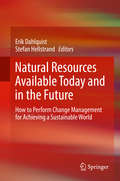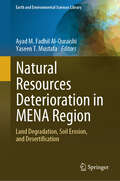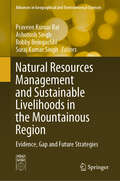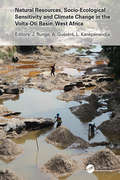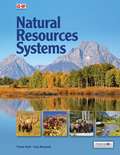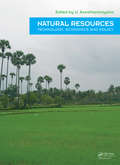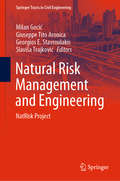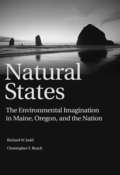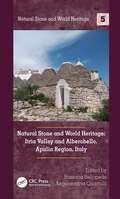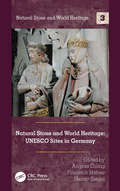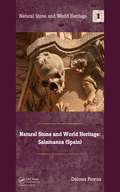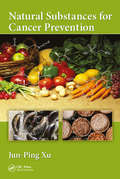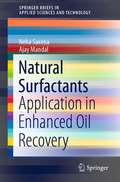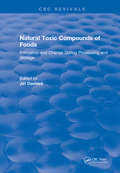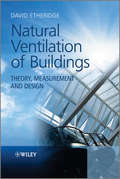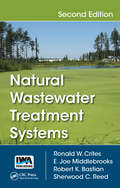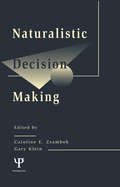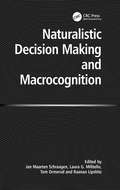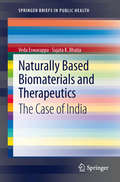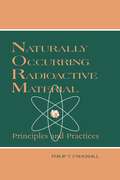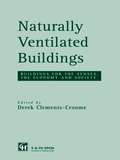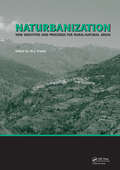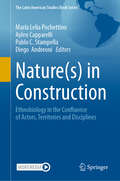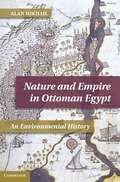- Table View
- List View
Natural Resources Available Today and in the Future
by Erik Dahlquist Stefan HellstrandThis book focuses on providing an overview of all our available natural resources, considering the sustainability and potential for power generation of each. Energy efficiency prospects of each natural resource are examined in the context of society's key energy needs- Heating/cooling, Electric Power, Transportation and Industrial Production. Geography, climate and demographics are all discussed as key vectors impacting the comparative opportunities for self-sustenance around the globe. The authors provide in-depth coverage of renewable energy upscale and energy efficiency improvements in industry and society within a historical context, including a keen look at the variable effectiveness of different policy tools that have been used to support the transition away from unsustainable resource use. Finally, suggestions for more sustainable futures are provided, from improved policy measures, to new technological horizons in areas from offshore wind and marine energy to biogas and energy storage.
Natural Resources Deterioration in MENA Region: Land Degradation, Soil Erosion, and Desertification (Earth and Environmental Sciences Library)
by Ayad M. Fadhil Al-Quraishi Yaseen T. MustafaLand deterioration, drought, desertification, and water resources shrinkage threaten natural resources, negatively impacting environmental, economic, and political stability. The increasing occurrence of climate change (extremes) impacts land degradation processes, soil erosion by water and wind, and salinization. The researchers have invested several years of scientific research in natural resources deterioration, including soil degradation and erosion, land degradation, desertification, and climate changes, which are interesting enough. However, the link between science and policymaking appears to be less active as serious actions do not take fast. The eighteen chapters of this book focus more on topics related to natural resources deterioration, such as land degradation, desertification, drought, climate change, and analysis of numerous case studies. This book presents experts' overviews, study results, experiences, and knowledge of natural resources deterioration in MENA countries. It attracts researchers, experts, scholars, scientists, academics, students, practitioners, graduates, or anybody interested in land degradation, desertification, climate change, and natural hazards that fall within natural resources deterioration. Therefore, researchers keep continuing to do their investigations and produce results that convince stakeholders and policymaking to act immediately towards protecting natural resources and their sustainability.
Natural Resources Management and Sustainable Livelihoods in the Mountainous Region: Evidence, Gap and Future Strategies (Advances in Geographical and Environmental Sciences)
by Praveen Kumar Rai Ashutosh Singh Suraj Kumar Singh Bobby BeingachhiThis book explores the relationships between natural resources management, sustainable livelihoods, and integrated watershed management in the context of the mountainous region, especially in the northeastern region of India. The book also sheds light on the current state of regional issues, identifies gaps in the existing practices and proposes future policies for effective conservation and sustainable development.The environmental degradation in the northeastern region of India is basically attributed to the increasing biotic pressure on the fragile ecosystems in the absence of suitable investments and proper management practices to enhance and conserve the natural resources. Population growth and poverty on the one hand and the pressure of rising demand from wealth and consumerism on the other hand, have been exerting powerful pressure on the ecosystems. Natural resources planning and management and sustainable livelihoods through integrated watershed management is not just a technical challenge; it is also a social challenge. The book is a valuable resource for policymakers, researchers, practitioners and stakeholders involved in natural resource management, sustainable development and watershed management in the Himalayan region.
Natural Resources, Socio-Ecological Sensitivity and Climate Change in the Volta-Oti Basin, West Africa
by Jürgen RungeThis book presents the outcome of an interdisciplinary and international workshop supported by the Volkswagen Stiftung (funding line ‘Knowledge for Tomorrow’) on the topic of ‘Natural Resources, Socio-Ecological Sensitivity and Climate Change in the Volta-Oti Basin, West Africa’. The conference was jointly organised by Goethe-University Frankfurt (Germany) and the University of Kara (Togo) held from March 6 to 8, 2019 in northern Togo. It aimed to strengthen capacities of junior scientists from the sub-region, exchange and mobilise theoretical and methodological background from various scientific fields (Botany, Construction, Geology, Geography, Infrastructure, Politics, Remote Sensing, Sociology and Urban Planning). One goal was to deliver reliable elements for ongoing and profound environmental analyses that lie outside the common questions of the academic and civil society stakeholders. Ecosystem fragmentation and deforestation in West Africa are mainly triggered by humans such as agriculture and small-scale forest disturbances for charcoal and firewood production. Increasing population pressure, declining of carrying capacity and demand for agricultural land caused the reduction of land conservation capacities, even in protected areas. The complexity of interactions between environmental and socio-ecological systems and subsequent effects (sensitivity) has raised ongoing international awareness in light of ongoing climate change. By the example of natural resources, land use and stakeholders’ perceptions within the Volta-Oti Basin the book’s proceedings present, discuss and distribute new findings that will sustainably stimulate the international debate. The workshop also intended to overcome national borders and language barriers between the Anglophone (Ghana) and the Francophone (Benin, Burkina Faso, Ivory Coast, Togo) research communities, and supported better West African cooperation and networking. The young as well as the established partners formed new collaborations, and the event at the University of Kara (Togo) was a truly unique opportunity for all involved, not only to discuss science, but also to assess applied and best future management practices for the Oti-Volta Basin in West Africa.
Natural Resources Systems
by Travis D. Park Tara L. BerescikNatural Resources Systems is a comprehensive text that features up-to-date coverage of today's natural resources management, including a focus on sustainability, global environmental issues, and the science behind the solutions to natural resources issues. It provides students with a basic introduction to many areas included in natural resources studies, including soil, air, water, endangered species, fisheries, game management, and cartography. Diverse conservation and natural resources management careers are highlighted in the Career Connection features throughout the text to provide students with examples of career paths taken by some of today's successful professionals. Special attention is given to the art of program, which includes pictures, charts, graphs, and illustrations, to education readers and help those who struggle with comprehension. Abundant STEM Connections, Environmental Features, and instructional features throughout the text help students learn by doing.
Natural Resources - Technology, Economics & Policy
by U. AswathanarayanaNatural resources management has two principal dimensions : Science-illuminated (earth, space, hydrological, pedological, information, etc. sciences) management of local resources (waters, soils, bioresources, minerals, rocks, sediments, etc.) in an ecologically-sustainable manner, and Value-addition through processing of natural products, through
Natural Risk Management and Engineering: NatRisk Project (Springer Tracts in Civil Engineering)
by Milan Gocić Giuseppe Tito Aronica Georgios E. Stavroulakis Slaviša TrajkovićThis book summarizes the research being pursued as part of the Erasmus+ CBHE KA2 project entitled "Development of master curricula for natural disasters risk management in Western Balkan countries” (NatRisk), which aims to educate experts on the prevention and management of natural disasters in the Western Balkan region in line with national and EU policies. The project has successfully developed and implemented master curricula and educational training in the field of natural disasters risk management, and a methodology for the identification and prevention of natural disasters. Consisting of 11 chapters, the book analyzes and discusses topics such as risk assessment tools and quality methods, the different approaches for civil-military collaboration, natural disasters risk management in Bosnia and Herzegovina, leadership models for managing crises resulting from natural disasters, natural disasters in industrial areas, natural risk management in geotechnics, flood risk modeling, adaptive neuro-fuzzy inference models for flood prediction, collapse prediction of masonry arches, an algorithm for fire truck dispatch in emergency situations, and processing drought data in a GIS environment.
Natural States: "The Environmental Imagination in Maine, Oregon, and the Nation"
by Richard W. JuddRichard Judd and Christopher Beach define the environmental imagination as the attempt to secure 'a sense of freedom, permanence, and authenticity through communion with nature.' The desire for this connection is based on ideals about nature, wilderness, and the livable landscape that are personal, variable, and often contradictory. Judd and Beach are interested in the public expression of these ideals in post-World War II environmental politics. Arguing that the best way to study the relationship between popular values and politics is through local and regional records, they focus on Maine and Oregon, states both rich in natural beauty and environmentalist traditions, but distinct in their postwar economic growth. Natural States reconstructs the environmental imagination from public commentary, legislative records, and other documents. Judd and Beach trace important divisions within the environmental movement, noting that they were balanced by a consistent, civic-minded vision of environmental goods shared by all. They demonstrate how tensions from competing ideals sustained the movement, contributed to its successes, but also limited its achievements. In the process, they offer insight into the character of the broader environmental movement as it emerged from the interplay of local, state, and national politics. The study ends in the 1970s when spectacular legislative achievements at the national level were masking a decline in mainstream civic engagement in state politics. The authors note the rise of the private ecotopia and the increasing complexity in the way Americans viewed their connections with the natural world. Yet, today, despite wide variations in beliefs and lifestyles, a majority of Americans still consider themselves to be environmentalists. In Natural States, environmental politics emerges less as a conflict between people who do and do not value nature, and more as a debate about the way people define and then chose to live with nature. In their attempt to place the passion for nature within a changing political and cultural context, Judd and Beach shed light on the ways that ideals unify and divide the environmental movement and act as the source of its enduring popularity.
Natural Stone and World Heritage: Itria Valley and Alberobello, Apulia Region, Italy (ISSN)
by Rossana Bellopede Angelamaria QuartulliApulian limestones constitute the historic building constructions of the Puglia region (in the south of Italy) named trulli (representing an outstanding universal value for UNESCO), but also other stone buildings of the well-known Itria Valley. Trulli are drywall (mortarless) constructions made of roughly worked limestone blocks collected from neighbouring fields. The limestone for trulli is quarried from different Apulian localities and, together with another local lithotype, represents the stone heritage of the Itria Valley.This book begins with an introduction to the region of southern Italy where trulli and other typical stone architecture can be found. The Itria Valley with its towns and landscape and the town of Alberobello are described from an architectural point of view. The second section describes the different examples of building constructions in local stone of the Itria Valley, focusing on ancient and contemporary quarries. In this part petrographic and physical mechanical characteristics of the main kind of limestones are reported and discussed. The third part focuses on the main examples of stone architecture of Itria Valley, distinguishing the historical rural buildings from the other historical civil ones. In this section particular attention is given to best practices of evaluation action, protection rules and restoration methods for stone heritage in Itria Valley and Alberobello.This book serves as a useful source of information to geologists, archaeologists, architects, historians and stone industry operators specifically, and to academic and non-academic communities, travellers, and tourism industry operators in general. The book will also be of interest to students, researchers, and rock enthusiasts spanning all age groups and academic levels.
Natural Stone and World Heritage: UNESCO Sites in Germany (Natural Stone and World Heritage)
by Angela Ehling Friedrich Häfner Heiner SiedelThere are many UNESCO World Heritage Sites in Germany. Most of them are built with natural stones. These sites are commonly presented to the public with a lot of information regarding historical, cultural and artistic aspects. Mostly, there is no focus on the main building material if it concerns natural stones. This work aims to show that it is precisely the natural stone that lends the sites their distinctive character. The used stones demonstrate the context and the interaction with the geology of the surrounding countryside as well as possibilities of transport and treatment. They reflect the culture and society at the time of the building phases. The second part of the work presents the most important stones that were used at these sites, along with their occurrences, aspects of quarrying in historical times and of course their petrographical, mineralogical and technical features. It is shown how these features influence the weathering of the stones and how restoration of stones is carried out. The book will serve as a useful source book for geologists, archaeologists, architects, representatives of the natural stone industry, historians and cultural heritage management professionals specifically, and for academic and nonacademic communities, travelers and tourism industry operators in general.
Natural Stone and World Heritage: Salamanca (Spain) (Natural Stone and World Heritage)
by Dolores PereiraHeritage stones are those stones that have been used for many years, even centuries, to build the historic buildings and monuments of places around the world. Some of these stones are still being used for construction, but others are no longer used, either because quarries were exhausted or closed or because architects and constructors do not know about their particularities and importance. Several scientific papers discuss many of these stones, and a number of papers are currently being prepared, but this book is the first to emphasize the importance and significance of natural stone in the construction of a city, Salamanca, recognized as a World Heritage Site by UNESCO since 1988. In light of this recognition, Salamanca has a duty to preserve all historic buildings that make up the city by restoring those that are starting to deteriorate centuries after their construction. <P><P>This book describes the buildings, the stones (all quarried centuries ago in the surrounding area), and the stone quarries, some of them inactive for many years, but that should still allow extraction of blocks on demand to restore and replace damaged specimens in the buildings, preserving the very character that saw the city receive recognition by UNESCO in the first place. There are many other places around the world that should follow this initiative and disseminate the importance of their heritage stones. This book will be of interest to professionals and academics in Geology, Engineering, architectural and artistic work in stone, both construction and conservation, but also to the general public.
Natural Substances for Cancer Prevention
by Jun-Ping XuNatural Substances for Cancer Prevention explores in detail how numerous investigations in chemical biology and molecular biology have established strong scientific evidence demonstrating how the properties of naturally occurring bioactive chemicals hamper all stages of cancers (from initiation to metastasis). Accordingly, important goals for cancer prevention are the modification of our dietary habits and an increase in the intake of more anticancer-related natural substances. More significantly, the bioactive chemicals presented in the functional foods should be readily available, inexpensive, non-toxic, and nutritional.
Natural Surfactants: Application in Enhanced Oil Recovery (SpringerBriefs in Applied Sciences and Technology)
by Neha Saxena Ajay MandalThis book focuses on the use of natural surfactants in enhanced oil recovery, providing an overview of surfactants, their types, and different physical–chemical properties used to analyse the efficiency of surfactants. Natural surfactants discuss the history of the surfactants, their classification, and the use of surfactants in petroleum industry. Special attention has been paid to natural surfactants and their advantages over synthetic surfactants, including analysing their properties such as emulsification, interfacial tension, and wettability and how these can be used in EOR. This book offers an overview for researchers and graduate students in the fields of petroleum and chemical engineering, as well as oil and gas industry professionals.
Natural Toxic Compounds of Foods
by Jiri DavidekThis book summarizes the knowledge of naturally occurring toxic and antinutritive food compounds. It includes those plants and animals of value or potential value for human nutrition, either by direct consumption or indirect. as feed for domestic animals. Also included are toxic and antinutritive compounds formed from food components during processing and storage, as well as the toxic and antinutritive compounds present as natural constituents in raw materials and foodstuffs. FEATURES: Discusses food intolerance-inducing compounds, toxins and toxic compounds; Focuses on the most frequently occurring intolerances; Describes the reaction conditions for the formation of these compounds, as well as for their degradation; Considers nitroso compounds and ethyl carbamate formation.
Natural Ventilation of Buildings
by David EtheridgeNatural ventilation is considered a prerequisite for sustainable buildings and is therefore in line with current trends in the construction industry. The design of naturally ventilated buildings is more difficult and carries greater risk than those that are mechanically ventilated. A successful result relies increasingly on a good understanding of the abilities and limitations of the theoretical and experimental procedures that are used for design.There are two ways to naturally ventilate a building: wind driven ventilation and stack ventilation. The majority of buildings employing natural ventilation rely primarily on wind driven ventilation, but the most efficient design should implement both types.Natural Ventilation of Buildings: Theory, Measurement and Design comprehensively explains the fundamentals of the theory and measurement of natural ventilation, as well as the current state of knowledge and how this can be applied to design. The book also describes the theoretical and experimental techniques to the practical problems faced by designers. Particular attention is given to the limitations of the various techniques and the associated uncertainties.Key features:Comprehensive coverage of the theory and measurement of natural ventilationDetailed coverage of the relevance and application of theoretical and experimental techniques to designHighlighting of the strengths and weaknesses of techniques and their errors and uncertaintiesComprehensive coverage of mathematical models, including CFDTwo chapters dedicated to design procedures and another devoted to the basic principles of fluid mechanics that are relevant to ventilationThis comprehensive account of the fundamentals for natural ventilation design will be invaluable to undergraduates and postgraduates who wish to gain an understanding of the topic for the purpose of research or design. The book should also provide a useful source of reference for more experienced industry practitioners.
Natural Wastewater Treatment Systems
by Ronald W. Crites E. Joe Middlebrooks Robert K. BastianCalling for ecologically and economically sound wastewater treatment systems, the authors of Natural Wastewater Treatment Systems explore the use of wetlands, sprinkler or deep irrigation, groundwater recharge, and other natural systems as sustainable methods for the treatment and management of wastewater. Based on work by prominent experts in natu
Naturalistic Decision Making (Expertise: Research and Applications Series)
by Caroline E. Zsambok Gary KleinIf you aren't using the term naturalistic decision making, or NDM, you soon will be. Even as a very young field, NDM has already had far-reaching applications in areas as diverse as management, aviation, health care, nuclear power, military command and control, corporate teamwork, and manufacturing. Put simply, NDM is the way people use their experience to make decisions in the context of a job or task. Of particular interest to NDM researchers are the effects of high-stake consequences, shifting goals, incomplete information, time pressure, uncertainty, and other conditions that are present in most of today's work places and that add to the complexity of decision making. Applications of NDM research findings target decision aids and training that help people in their decision-making processes. This book reports the findings of top NDM researchers, as well as many of their current applications. In addition, the book offers a historical perspective on the emergence of this new paradigm, describes recent theoretical and methodological advancements, and points to future developments. It was written for people interested in decision making research and applications relative to a diverse array of work settings and products such as human-computer interfaces, decision support systems, individual and team training, product designs, and organizational development and planning.
Naturalistic Decision Making and Macrocognition
by Jan Maarten SchraagenThis book presents the latest work in the area of naturalistic decision making (NDM) and its extension into the area of macrocognition. It contains 18 chapters relating research centered on the study of expertise in naturalistic settings, written by international experts in NDM and cognitive systems engineering. The objective of the book is to present the reader with exciting new developments in this field of research, which is characterized by its application-oriented focus. The work addresses only real-world problems and issues. For instance, how do multi-national teams collaborate effectively? How can surgeons best be supported by technology? How do detectives make sense of complex criminal cases? In all instances the studies have been carried out on experts within their respective domains. The traditional field of NDM is extended in this work by focusing on macrocognitive functions other than decision making, namely sense-making, coordination and planning. This has broadened the scope of the field. The book also contains a theoretical discussion of the macro-micro distinction. Naturalistic Decision Making and Macrocognition will be relevant to graduate students, researchers and professionals (including professionals and researchers in business, industry and government) who are interested in decision making, expertise, training methods and system design. The material may be used in two ways: theoretically, to advance understanding of the field of naturalistic decision making; and practically, to gain insight into how experts in various domains solve particular problems, understand and deal with issues and collaborate with others.
Naturally Based Biomaterials and Therapeutics
by Sujata K. Bhatia Veda EswarappaThis book advances biomedical innovations to address the plethora of health problems afflicting the developing world. A panoply of cultural, economic, infrastructural, and other factors prevent many interventions currently popular in the developed world from being similarly effective in the developing world. This book discusses less-traditional approaches, such as naturally based biomaterials and therapeutics, an area that has traditionally been overlooked but has also demonstrated impressive potential for health applications in recent years. This book explores precisely the kinds of applications which can enable countries like India to access more effective, inexpensive treatments while also taking more ownership of their healthcare technologies and innovations.
Naturally Occurring Radioactive Materials: Principles and Practices
by T.Rick IrvinManagement of Naturally Occurring Radioactive Materials - known in the industry as NORM -has become an important part of the regular training required for workers in oil and gas production, refinery and petrochemical manufacturing, and in certain types of mining. Proper handling of NORM-contaminated wastes and use of appropriate radiation detection and protective equipment are now understood to be important components of good worker safety programs. Until now, no practical, easy-to-read, book was available to supplement worker training courses on NORM management. Naturally Occurring Radioactive Materials: Principles and Practices fills this void by providing, in a single publication, an ideal reference for industry managers, supervisors and line personnel. The book stresses the proper handling and management of NORM contaminated wastes and provides a firm understanding of the chemical properties of radioactive agents, their toxicological effects, and the appropriate containerization and disposal methods for these materials.
Naturally Ventilated Buildings: Building for the senses, the economy and society
by Derek Clements-CroomeWhile there are many historical examples of successful naturally ventilated buildings, standards for indoor climate have tended to emphasise active, mechanical airflow systems rather than passive natural systems. Despite its importance, knowledge about the performance of naturally ventilated buildings has remained comparatively sparse. With ten key research papers this book seeks to address this lack of information.
Naturbanization: New identities and processes for rural-natural areas
by M. J. PradosAs the growth of the worlds population requires the continued search for residential space, the urbanization of natural lands is an inevitable process, but that process does not have to be one that is accomplished without regard for environmental quality. This book presents the unique perspective of naturbanization, the urbanization of protected a
Nature: Ethnobiology in the Confluence of Actors, Territories and Disciplines (The Latin American Studies Book Series)
by María Lelia Pochettino Aylen Capparelli Pablo C. Stampella Diego AndreoniThis book provides the state of the art of ethnobiology in Argentina and related Latin American countries, highlighting timely trends and topics. It synthesizes studies resulting from the III Jornadas Argentinas de Etnobiología y Sociedad (III JAES—3rd Argentinian Meeting of Ethnobiology and Society), convened in La Plata in 2021. As a relatively new academic development, ethnobiology integrates approaches from different points of view, such as biology, anthropology, geography, history, linguistics, and, in a crucial recent advance, local perspectives. Consequently, this volume contains 33 contributions from 86 authors of different countries, orientations, and disciplines—but all related to interrelationships between people/s and the natural environment. Chapters cover a diverse array of topics, ranging from biocultural relationships and their historical construction through time to conservation of biocultural and agrodiversity, ethnomycology, ethnophycology, and meliponiculture and beyond. The volume’s main goal is to propitiate the preservation of biocultural diversity through the application of ethnobiological wisdom in a global context characterized by the accelerated loss of traditional knowledge. The contributions aim to transcend the nature/culture dichotomy, emphasizing the inextricable relationship between communities and their environment and the importance of acting jointly in the construction of the inhabited landscape and local identity.
Nature and Empire in Ottoman Egypt
by Alan MikhailIn one of the first environmental histories of the Ottoman Empire, Alan Mikhail examines relations between the empire and its most lucrative province of Egypt. Based on both the local records of various towns and villages in rural Egypt and the imperial orders of the Ottoman state, this book charts how changes in the control of natural resources fundamentally altered the nature of Ottoman imperial sovereignty in Egypt and throughout the empire. In revealing how Egyptian peasants were able to use their knowledge and experience of local environments to force the hand of the imperial state, Nature and Empire in Ottoman Egypt tells a story of the connections of empire stretching from canals in the Egyptian countryside to the palace in Istanbul, from Anatolian forests to the shores of the Red Sea, and from a plague flea's bite to the fortunes of one of the most powerful states of the early modern world.
Nature and Empire in Ottoman Egypt: An Environmental History
by Alan MikhailIn one of the first environmental histories of the Ottoman Empire, Alan Mikhail examines relations between the empire and its most lucrative province of Egypt. Based on both the local records of various towns and villages in rural Egypt and the imperial orders of the Ottoman state, this book charts how changes in the control of natural resources fundamentally altered the nature of Ottoman imperial sovereignty in Egypt and throughout the empire. In revealing how Egyptian peasants were able to use their knowledge and experience of local environments to force the hand of the imperial state, Nature and Empire in Ottoman Egypt tells a story of the connections of empire stretching from canals in the Egyptian countryside to the palace in Istanbul, from Anatolian forests to the shores of the Red Sea, and from a plague flea's bite to the fortunes of one of the most powerful states of the early modern world.
